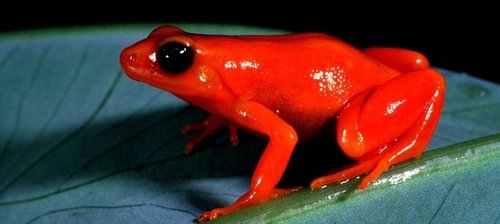Mantella aurantiaca

Name: Mantella aurantiaca
CITES Name: Mantella aurantiaca aurantiaca
French Common Name: Mantella aurantiaca
English common name: Madagascan Golden Frog
Japanese common name: Kiniro-Ade-Gaeru
Legislation: CITES Appendix 2
Classification:
Although it is not dendrobatidis, the first discoveries were baptized Mantellas wrongly "Dendrobates madagascariensis". It was not until 1882 that Baker established the genus Mantella. However, it should be noted that Mantella aurantiaca produces pumiliotoxines. Belongs to the genus Mantella Mantelidae family and subfamily Mantellinae. Some bibliographies sometimes two distinct subspecies based on color: Mantella aurantiaca aurantiaca and Mantella aurantiaca rubra. Since 1999, Mantella mylotympanum is now recognized as a separate species.
Location:
This species is endemic to Madagascar.
it has a very limited range, it is found only in some marshy areas located in a mountainous area (600m to 1200m) in the center of the island of Madagascar (Périnet).
Biotope:
This species is particularly fond of the surrounding swamps and marshes of a mountainous area cool and foggy.
This is an area subject to marked climatic seasons.
Temperature: 15 ° C to 24 ° C
Humidity: 90-95%
Morphology:
Is a kind of small: 18 to 22mm for males, 22 to 26 mm for females.
Its color is uniform, it varies from yellow orange to red depending on the locality of origin (yellow Beparasy, orange: Pandanus Forest & Torotorofotsy and orange-red: Anosibe).
The skin is slightly granular on the back of the animal. Unlike dendrobatidis, the Mantellas do not have suction cups under the legs. The ears are visible just behind the large black eyes. Sexual dimorphism is often remarkable: the females are generally larger and more "plump" while males are more "angular".
sexing is possible by observing the seminiferous canals.
Reproduction:
The Mantella aurantiaca are sexually mature at the age of 16 to 18 months, it is common that the first clutches are not fertile.
To allow good interaction between individuals, it is often advisable to host a group of four to five specimens (sex-ratio of 2 to 3 males per female) in a 60x40x40cm terrarium. To reproduce, adult frogs must suffer cold and dry winter (2 months at 10-15 ° C, length of day: 10 hours).
Breeding occurs during the wet season (20 to 24 ° C, 14 hours of light rain day).
Males emit a shrill voice eerily reminiscent of a cricket cry. This species also territorial fights (amplexus-like) are common during the breeding season. Females deposit 40 to 100 white eggs in cavities on the ground preferably in the dark. The eggs are then fertilized by one or more males up to 8 hours after laying. Unlike dendrobatidis, there is no parental care in Mantella. In nature, it is the heavy rains that cause the tadpoles to a water point. In the terrarium, it will leave the eggs and place them on the damp moss during incubation lasts 9-14 days depending on temperature. It will gradually increase the water level to allow hatching of tadpoles. Mantella tadpoles are not cannibalistic as it is possible to raise them in community. Complete metamorphosis is completed after



